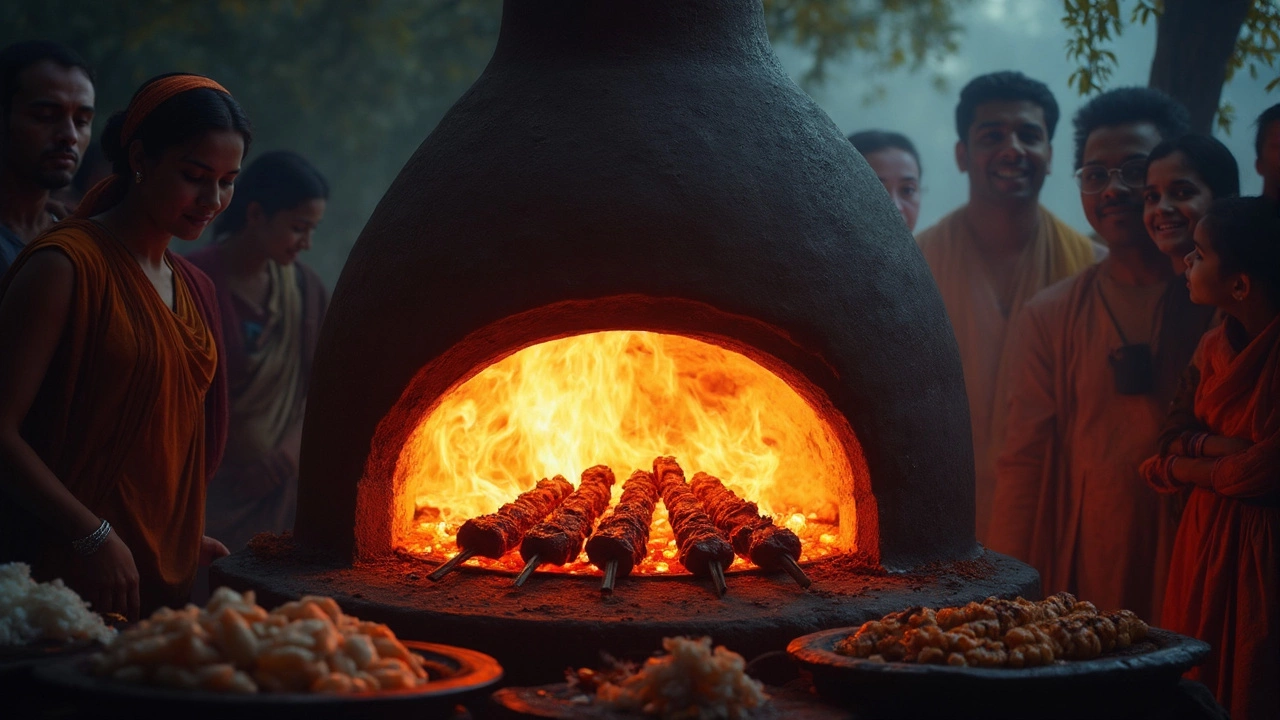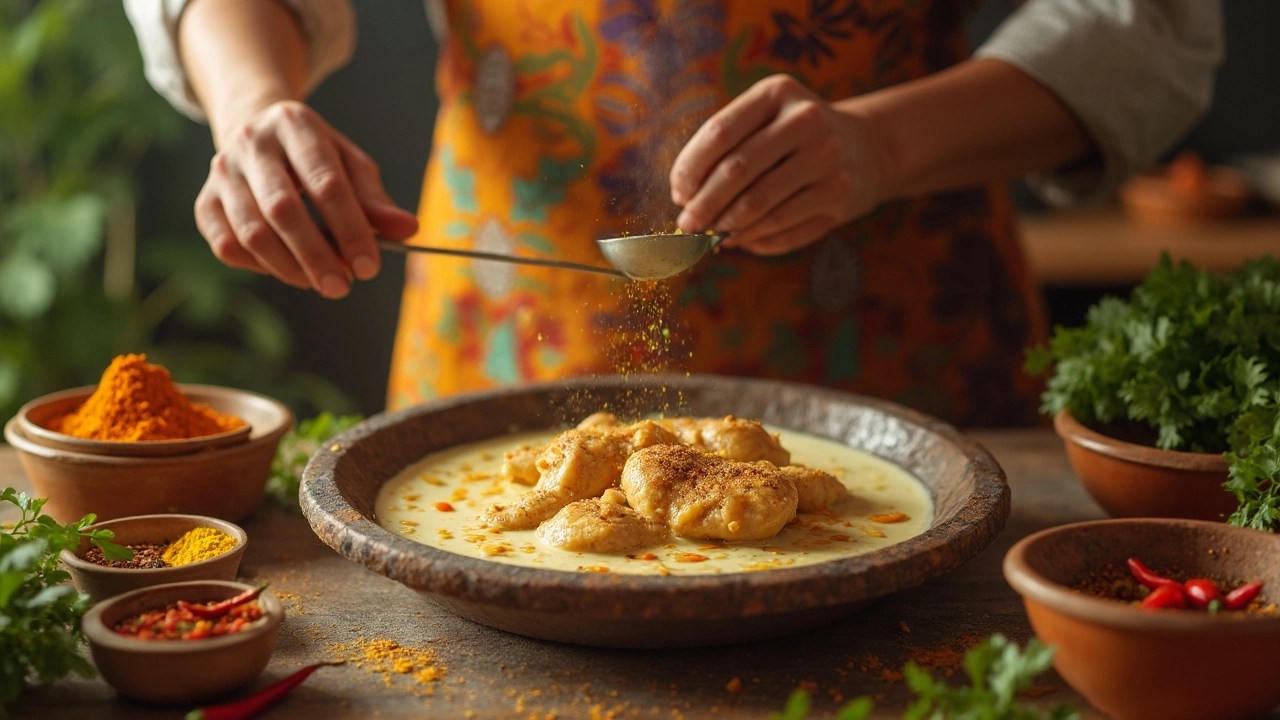If you’ve ever sunk your teeth into tandoori chicken, you know it’s ridiculously tender compared to most grilled chicken. At first glance, it feels like magic—how does this bright red chicken end up so juicy and soft, even though it’s cooked at high heat? Spoiler: it’s not magic, it’s smart cooking science (and a little bit of tradition).
The real game changer is the marinade. Tandoori chicken gets soaked in a mix of thick yogurt and spices for hours, sometimes overnight. Yogurt isn’t just there for flavor. Turns out, it contains mild acids and enzymes that break down tough proteins in the chicken. That’s the secret sauce for getting chicken that basically falls off the bone without being mushy.
- The Magic of Marinade
- The Science Behind Tenderness
- Cooking Method: Why Heat Matters
- Tips for Perfect Tandoori Chicken at Home
The Magic of Marinade
The difference between dry, chewy chicken and what you get with tandoori chicken comes down to the marinade. A good tandoori marinade isn’t just about coating the chicken; it’s about transforming it from the inside out. Traditional recipes always use thick, whole-milk yogurt as the base, which makes a huge difference. Yogurt contains lactic acid and natural enzymes that gently break apart muscle fibers—so while the chicken soaks, it literally gets more tender by the hour.
On top of the yogurt, you’ve got a mix of ground spices like cumin, coriander, turmeric, garam masala, and bright red Kashmiri chili powder. Adding garlic, ginger, salt, and lemon juice gives it another boost. The acid in lemon juice amps up the tenderizing effect, but don’t overdo the citrus or you risk making the texture mushy.
Here’s what typically goes into a classic tandoori marinade:
- Whole milk yogurt (not low-fat, the fat helps carry fat-soluble flavors)
- Kashmiri red chili powder for color and mild heat
- Turmeric for earthy taste and even more color
- Ginger and garlic paste for punchy flavor
- Lemon juice or vinegar for gentle acidity
- Salt to get the flavors deep inside the meat
- Mild, warm spices like cumin, coriander, and garam masala
The real pros let their chicken marinate overnight in the fridge; even 4–6 hours makes a noticeable difference though. But what’s going on in the bowl? The yogurt and spices do two things: they add flavor and they break down proteins so the meat softens up. Here are some numbers to show you what the marinade actually does:
| Marinating Time | Moisture Retention | Flavor Penetration |
|---|---|---|
| 30 minutes | Low | Surface only |
| 2 hours | Medium | Partial (about 1/4 inch deep) |
| Overnight (8-12 hours) | High | Full depth, juicy all the way through |
If you’re short on time, pierce the chicken with a fork or make shallow cuts so the marinade seeps in faster. But trust me, nothing beats a slow overnight soak for the most tender bite.
The Science Behind Tenderness
So, why does tandoori chicken turn out way softer than expected, even though it’s stuck in searing heat? The answer is pure food chemistry—and a little teamwork between acids, enzymes, and heat.
The real hero is yogurt. Yogurt naturally contains lactic acid and live cultures, which break down big, tough protein chains inside the chicken. This process is called denaturing. It sounds technical, but in practice, it just means those tough bits get loosened up so the meat feels soft and moist after cooking. Regular acidic marinades, like lemon juice or vinegar, work too but yogurt is gentler. It breaks down proteins without making the chicken stringy or mushy. That’s why chefs across India swear by yogurt for tender meats.
Here’s a quick look at what goes on while your chicken is soaking in that marinade:
- Lactic Acid: Helps unravel protein molecules (like a tangled ball of yarn becomes straight pieces), so the meat loses some of its chewiness.
- Proteolytic Enzymes: Natural enzymes in the yogurt further chop up those challenging muscle fibers.
- Salt: Most marinades include a good amount of salt, which pulls water into the muscle fibers and helps season the chicken all the way through.
- Spices: Things like cumin, coriander, and ginger offer more than flavor—they have their own enzymes and oils that add to the tenderizing effect.
This isn’t just a kitchen myth. A 2023 study from the Indian Institute of Food Processing Technology found that chicken marinated in yogurt-based mixtures for 6-8 hours had up to 30% lower toughness (measured by texture tests) compared to chicken marinated without yogurt.
| Marinade Type | Tenderness Increase (%) After 6 Hours |
|---|---|
| Yogurt-Based | 30% |
| Lemon Juice | 18% |
| No Marinade | 0% |
Bottom line: the combination of yogurt, salt, and spices all chipping away at the tough parts turns regular chicken into something that’s hard to mess up. The longer you let the marinade do its thing, the softer your tandoori chicken will be—without ever needing fancy hacks or additives.

Cooking Method: Why Heat Matters
Ever wondered why tandoori chicken stands out from other grilled meat? It’s all about how it hits the heat. Traditionally, tandoori chicken is cooked in a tandoor—a super-hot cylindrical clay oven. The temperature inside a tandoor can easily reach 900°F (480°C). That’s much hotter than your regular backyard grill or kitchen oven.
This extreme heat sears the outside of the chicken super fast. It locks in the juices while forming a slightly charred, smoky crust that fans absolutely love. At the same time, the intense environment cooks chicken quickly, so it doesn’t get a chance to dry out. If you cook chicken low and slow on an average grill and take too long, you’ll notice how it goes rubbery or stringy. The tandoor's heat just works differently.
Don’t have a tandoor at home? No problem. Here are a few ways to mimic that special heat:
- Cram your oven up to the highest temperature it’ll go—usually around 500°F (260°C)—and use the broiler to get that charred effect at the end.
- Use a pizza stone or heavy cast iron pan. Preheat it till it’s super hot, then lay down the marinated chicken. It’ll help get a smoky and crisp surface.
- If you’ve got a barbecue or charcoal grill, pile the coals to one side and place the chicken right over the hottest part. Charcoal brings some of that authentic smoky flavor, too.
What really sets tandoori chicken apart is this combination of quick, high heat and a good marinade. Without the blast of the tandoor, you’ll need to play with heat sources, but the results can still surprise you. Just remember, don’t shy away from high heat—it's the key for juicy, tender bites every time.
Tips for Perfect Tandoori Chicken at Home
You don’t need a clay oven or special equipment to pull off mouthwatering tandoori chicken at home. A few simple choices make all the difference when you want that juicy, tender bite. Here’s what works best for real results:
- Tandoori chicken needs a good marinade, so let it sit for at least 6 hours. Overnight in the fridge is even better. The yogurt and lemon juice have time to work their magic, so don’t rush this step.
- Use full-fat Greek or plain yogurt. Lower-fat versions don’t coat the chicken as well and won’t keep it as moist.
- Slash the chicken with a sharp knife before marinating. This helps all the flavors soak inside, not just sit on the surface.
- Always include salt in your marinade—it helps the chicken retain moisture as it cooks. Some home cooks swear by a little gram flour (besan) in the marinade to stick spices and seal juices in.
- Don’t overcrowd your baking tray or grill. When each piece gets direct heat, you get charred edges without drying out the meat.
- If you can, use the broiler at the end for 2-3 minutes to mimic tandoor-like char. Or finish pieces on a hot cast iron pan for that smoky edge.
- For a smoky aroma, try the ‘dhungar’ method: heat a lump of charcoal, place it in a bowl with a little ghee, set this in your tray of just-marinated chicken, cover tightly for a few minutes, then cook as usual.
Here’s a quick reference for easy tweaks that really improve texture and flavor:
| Step | Ideal Method | Common Mistake | Why It Matters |
|---|---|---|---|
| Marinating | 8+ hours, yogurt-based | 30-minute quick soak | Short marination won’t tenderize or flavor the chicken deeply |
| Chicken cut | Bone-in thighs/drumsticks | Boneless breasts only | Bones retain juiciness, white meat dries out |
| Cooking heat | High & fast (oven/grill/broil) | Low or uneven heat | Hot cooking seals juice and gives smoky flavor |
If you want to go the extra mile, invest in a food thermometer. The sweet spot is around 165°F (74°C) for chicken—safe to eat, but not overdone. Lastly, resist slicing right after cooking. Cover and let your chicken rest for 5-10 minutes. That pause lets juices settle instead of running out, so every piece stays juicy, just like your favorite restaurant.
